comments? corrections?
email me at
lukerobt@history.ucsb.edu
4 mon Kan'ei and Bunkyuu coins
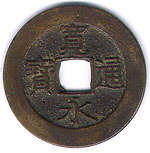
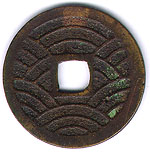
|
comments? corrections? |
4 mon Kan'ei and Bunkyuu coins
|
|
The Tokugawa government first commissioned in 1768 a Kan'ei Tsuuhou coin valued at 4 mon. The first version was made at the Fukagawa mint in Edo and had a design of 21 waves on the back of the coin (see image above). In 1769 the design of the reverse changed to have only 11 waves and all subsequent versions used the 11 wave design. It was not much larger than a 1 mon coin (27-28 mm vs 25-26 mm) and so it was cost effective to produce. This was desirable in a time when there was a growing scarcity of copper. Because the economy itself was usually growing in this period the coins were readily accepted by users. The government ordered a new batch of this same coin made in the period 1821-1825. These are largely identical but the quality is much moer varied, which is to say that many of the 4 mon from this era are of poor manufacture. The metal content of these also tend to be more on the reddish side than the earlier coins which have a higher admixture of other metals than copper. Because these coins were manufactured in the Bunsei period (1818-1829) They are called Bunsei coins by collectors, in contrast to the earlier ones which are called Meiwa coins (from the Meiwa era 1764-1771). The Bunsei coins are as common as the Meiwa coins. One more period of minting was in the Ansei era (1854-1859). There is variation but they tend to be on the yellowish brassy side and the file used to smooth the face is very rough, leaving clear file marks on the face. In 1860, under grave financial difficulties the Tokugawa government began minting the coin in iron but this was relatively unsuccessful and the coins are moderately uncommon. Because the 4 mon coin was relatively profitable to make there are many counterfeits produced by private mints, and/or clandestine daimyo mints. From around the year 1866 many domains also officially received permission to mint 4 mon coins to help with their own finances. these were all made of iron and many of them have special markings on the back, usually a character identifying the name of the mint. Although the Tokugawa overlords gave some domains permission to produce iron Kan'ei coins from 1866, The Tokugawa itself started producing a 4 mon coin with a new legend in 1863. This is the Bunkyuu eihou. Bunkyuu refers to the Bunkyuu era which lasted from 1861-1863. Eihou means something like eternal cash or eternally circulating cash. To Tokugawa government however collapsed a mere 5 years after minting the coin and its hopeful name did not come true. It is interesting that the government chose to use a new and current era name for the coin, rather than sticking with the tradition of the Kan'ei moniker. Perhaps the rulers was hoping that a new era meant a reformation and invigoration of Tokugawa rule, but the new era actually meant collapse. Most of my information for this page comes from Shizuoka Izumika comp., Anasen Nyuumon Kan'ei Tsuuhou: Shin Kan'ei no bu (Shoshinkan:Tokyo, 1997). In the explanation box on the left of each coin I occasionally use some Japanese characters. If you cannot set your browser to read Japanese then these will appear garbled, but you can safely ignore them. |
|
This is the first type of 4 mon coin made. It has 21 waves on the back. The top center character, "kan" has two legs on the bottom. These are squat which is the common variety. If the legs are long and the "kan' seems to be standing up higher then it is the rare version of this coin. 明和 21波 |
  |
|
This is the second type of 4 mon coin made. It has 11 waves on the back and was first minted in 1769. Within the broader catagory of 1769 Meiwa coin, this coin is of the "fuei" type, which means that the bottom "ei" character is large and crouching. One way to easily identify this type is the the nub at the top roof of the left "hou" character protrudes a little down through the lid of that character. This is the most common type of Meiwa era coin. This coin was one of a number of 4 mon coins kindly given to me by a good friend in Kochi, Japan. 明和 11波 俯永 |
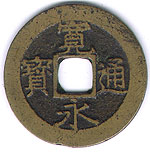 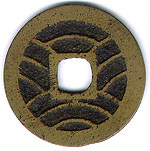 |
|
This is also the second type of 4 mon coin made. Within the broader category of 1769 Meiwa coin this is known as "Shouji" or "Correct Character," meaning that it is the standard character shape. Note that the dash on the roof on the "ho" character does not protrude through the top. 28.3 mm x 1 mm 明和 11波 正字 |
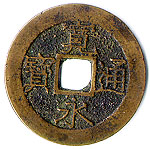 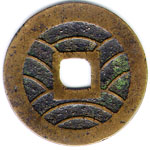 |
|
Here is an example of the Bunsei era version of the same coin, which was minted from 1821-1825. Bunsei coins tend to be redder and less carefully made than the Meiwa versions. Note the rough file marks on the back of the coin, and also the hole under the tsuu character. Within the Bunsei category this is also known as the "small character" type.
27.5 mm x 1 mm 文政 小字 |
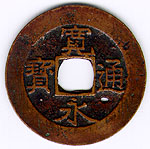 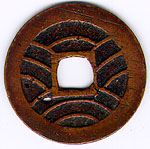 |
|
Iron 4 mon Kan'ei coins These iron varieties were all made from the mid 1860's under the auspices of various domains. Japan was in the midst of a revolutionary situation, the government was overthrown in 1868, and many lords were impoverished. The Tokugawa overlords gave permission to many daimyo lords to cast coins in order to help their finances and perhaps keep allies. Of course, many domains just made counterfiet 4 mon without bothering to ask for permission. |
|
Here is an example of an iron version of the coin which was made by Aizu domain (but within its Edo mansion at Fukagawa ward) from 1866. Most simply it can be recognized by the line curving down left just above the center hole. This line is the katakana character "no." Within the Aizu coins there are two main types. One is the "fat no," and the other is the "thin no" (hosono) which is pictured here. The thin no is a moderately uncommon coin and the fat no is rather uncommon. 27.5 mm x 1 mm 会津 背細ノ |
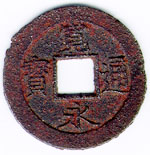 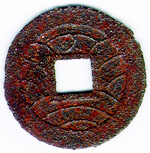 |
|
Here is an example of an iron version of the coin which was made by Morioka domain from around 1866. On the back is the character "mori" from Morioka. Because it is difficult to cast iron delicately the complicated "mori" usually is indistinct. 27.5 mm x 1 mm 盛岡 背盛 中様 |
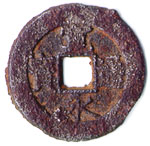 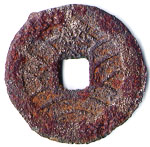 |
|
This coin was minted in Sendai from around 1866. On the back is the character "sen"千 meaning one thousand. this character is a homonym for the "sen" of Sendai, which means "mountaineer." The specific type of this coin is known as "tsumesen" meaning that the top stroke of the "sen" character is fat like a cut fingernail. Note that the middle cross stroke of the "sen" overlaps with the wave, making it thicker in the middle. This is important to note so as not to confuse this coin with the one from Ise Tsuu domain which has a katakana "i" (イ)on the back. If you are unsure, the "tsuu" character of the two is quite different. the Sendai coin has the triangular マ top while the one below has a rectangular ユ top. 28.5 mm x 1 mm 仙台 背千 爪千 |
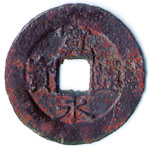 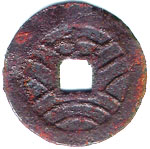 |
|
This coin is the Ise coin mentioned above, aslo manufactured from 1866. Bill Dunkle kindly gave this to me. The "i" character on the back refers to Ise Tsuu domain of the Todo clan. The craftsman who made this, Tanaka Iwakazu (Iwaichi?), also worked for Mito and Aizu. Note the similarity of manufacture especially with the Aizu coin above and to a lesser degree with the Mito coin below. The Aizu and Ise coins were manufactured in Edo for the domains rather than in the domains themselves. 27 mm x 1.2 mm 伊勢津 降波 |
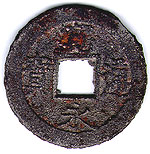 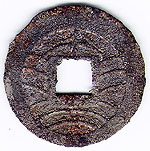 |
|
This coin was minted in Mito domain officially from around 1866. On the back is the katakana character "to." Likely this is the "to" of Mito. This coin was manufactured in Mito domain under the direction of Tanaka Iwakazu. His own recollections say he made it from as early as 1862, which conflicts with official records. Official records can lie and memories can fail so I do not really know which is correct. 28 mm x 1 mm 水戸 背ト 濶字 |
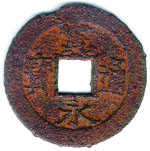 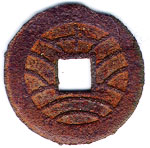 |
|
This coin was also minted in Mito domain at around the same time, but there is no character on the back.It is no more uncommon than the one above. This particular coin is of the "chuusen" type which denotes a middle size hole. the "ei" characteron this one is very distinctive, and oeverall the casting is very nice. 28 mm x 1 mm 水戸 背ト刮去 中穿 |
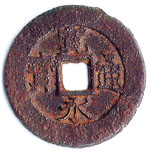 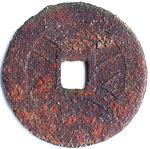 |
|
This is one of the Bunkyuu Eiho ("eternal treasure of the Bunkyuu era") minted from 1863. This is the "soubun" which means "cursive script" style, although it is hardly cursive. Only the first two strokes of the Bun character are slightly less than formal and the rest are formal script. The three basic types are pictured here. All three types are common. 26.5 mm x 1 mm 文久永寳 草文 |
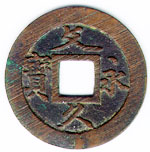 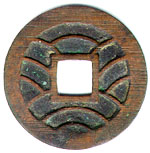 |
|
This is the second of the basic Bunkyuu Eiho types. It is known as the "ryakuhou" or "simplified Hou" type, and also known as the "tamahou" type meaning "Hou written with the character 'tama'" in it. Bunkyuu Eihou tend to be brassy or blackish in color and the file marks are rough and clearly visible. 26.5 mm x 1 mm 文久永寳 略宝/玉宝 |
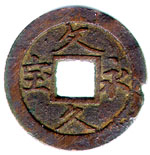 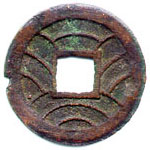 |
|
This is the third of the basic Bunkyuu Eiho types. It is known as the formal script type because the top of the Bun character has a standing dash over a horizontal line. Within the type this is known as the "thin character" subtype and is the most common. 27 mm x 1 mm 文久永寳 真文細字 |
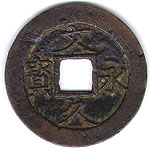 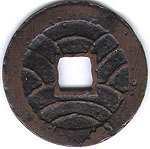 |